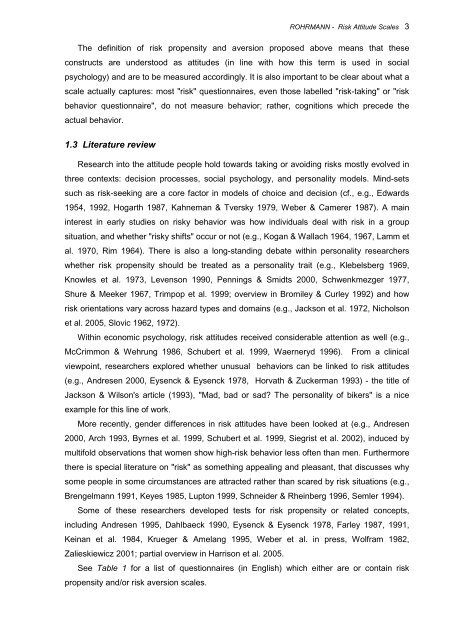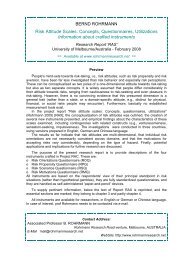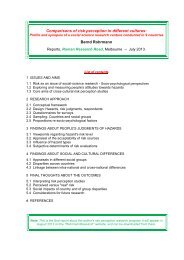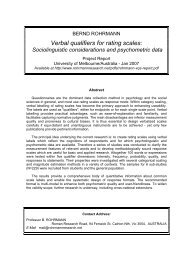Risk Attitude Scales: Concepts, Questionnaires, Utilizations
Risk Attitude Scales: Concepts, Questionnaires, Utilizations
Risk Attitude Scales: Concepts, Questionnaires, Utilizations
Create successful ePaper yourself
Turn your PDF publications into a flip-book with our unique Google optimized e-Paper software.
ROHRMANN - <strong>Risk</strong> <strong>Attitude</strong> <strong>Scales</strong> 3<br />
The definition of risk propensity and aversion proposed above means that these<br />
constructs are understood as attitudes (in line with how this term is used in social<br />
psychology) and are to be measured accordingly. It is also important to be clear about what a<br />
scale actually captures: most "risk" questionnaires, even those labelled "risk-taking" or "risk<br />
behavior questionnaire", do not measure behavior; rather, cognitions which precede the<br />
actual behavior.<br />
1.3 Literature review<br />
Research into the attitude people hold towards taking or avoiding risks mostly evolved in<br />
three contexts: decision processes, social psychology, and personality models. Mind-sets<br />
such as risk-seeking are a core factor in models of choice and decision (cf., e.g., Edwards<br />
1954, 1992, Hogarth 1987, Kahneman & Tversky 1979, Weber & Camerer 1987). A main<br />
interest in early studies on risky behavior was how individuals deal with risk in a group<br />
situation, and whether "risky shifts" occur or not (e.g., Kogan & Wallach 1964, 1967, Lamm et<br />
al. 1970, Rim 1964). There is also a long-standing debate within personality researchers<br />
whether risk propensity should be treated as a personality trait (e.g., Klebelsberg 1969,<br />
Knowles et al. 1973, Levenson 1990, Pennings & Smidts 2000, Schwenkmezger 1977,<br />
Shure & Meeker 1967, Trimpop et al. 1999; overview in Bromiley & Curley 1992) and how<br />
risk orientations vary across hazard types and domains (e.g., Jackson et al. 1972, Nicholson<br />
et al. 2005, Slovic 1962, 1972).<br />
Within economic psychology, risk attitudes received considerable attention as well (e.g.,<br />
McCrimmon & Wehrung 1986, Schubert et al. 1999, Waerneryd 1996). From a clinical<br />
viewpoint, researchers explored whether unusual behaviors can be linked to risk attitudes<br />
(e.g., Andresen 2000, Eysenck & Eysenck 1978, Horvath & Zuckerman 1993) - the title of<br />
Jackson & Wilson's article (1993), "Mad, bad or sad? The personality of bikers" is a nice<br />
example for this line of work.<br />
More recently, gender differences in risk attitudes have been looked at (e.g., Andresen<br />
2000, Arch 1993, Byrnes et al. 1999, Schubert et al. 1999, Siegrist et al. 2002), induced by<br />
multifold observations that women show high-risk behavior less often than men. Furthermore<br />
there is special literature on "risk" as something appealing and pleasant, that discusses why<br />
some people in some circumstances are attracted rather than scared by risk situations (e.g.,<br />
Brengelmann 1991, Keyes 1985, Lupton 1999, Schneider & Rheinberg 1996, Semler 1994).<br />
Some of these researchers developed tests for risk propensity or related concepts,<br />
including Andresen 1995, Dahlbaeck 1990, Eysenck & Eysenck 1978, Farley 1987, 1991,<br />
Keinan et al. 1984, Krueger & Amelang 1995, Weber et al. in press, Wolfram 1982,<br />
Zalieskiewicz 2001; partial overview in Harrison et al. 2005.<br />
See Table 1 for a list of questionnaires (in English) which either are or contain risk<br />
propensity and/or risk aversion scales.





